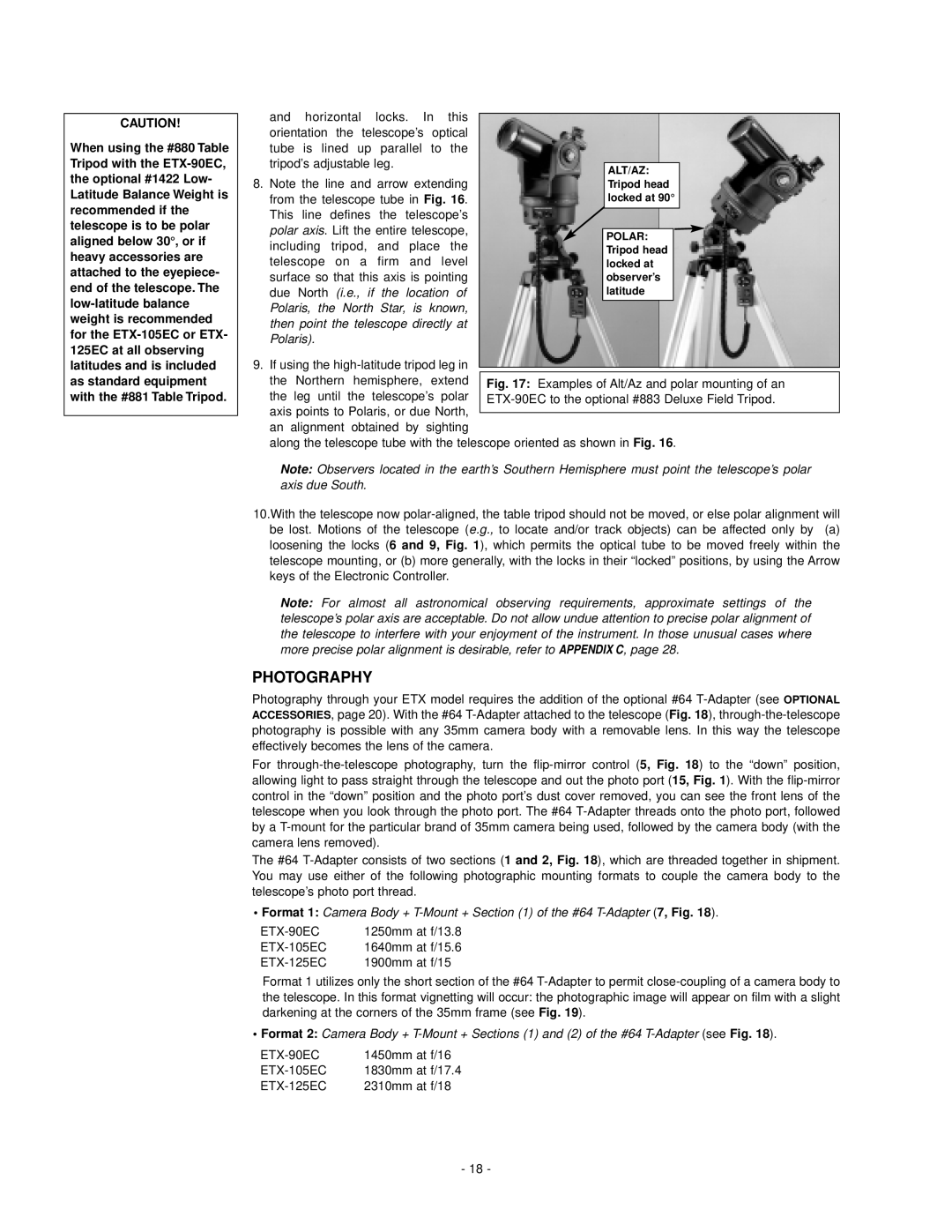and horizontal locks. In this orientation the telescope’s optical tube is lined up parallel to the tripod’s adjustable leg.
8. Note the line and arrow extending from the telescope tube in Fig. 16. This line defines the telescope’s polar axis. Lift the entire telescope, including tripod, and place the telescope on a firm and level surface so that this axis is pointing due North (i.e., if the location of Polaris, the North Star, is known, then point the telescope directly at Polaris).
9. If using the high-latitude tripod leg in the Northern hemisphere, extend the leg until the telescope’s polar axis points to Polaris, or due North, an alignment obtained by sighting
along the telescope tube with the telescope oriented as shown in Fig. 16.
Note: Observers located in the earth’s Southern Hemisphere must point the telescope’s polar axis due South.
10.With the telescope now polar-aligned, the table tripod should not be moved, or else polar alignment will be lost. Motions of the telescope (e.g., to locate and/or track objects) can be affected only by (a) loosening the locks (6 and 9, Fig. 1), which permits the optical tube to be moved freely within the telescope mounting, or (b) more generally, with the locks in their “locked” positions, by using the Arrow keys of the Electronic Controller.
Note: For almost all astronomical observing requirements, approximate settings of the telescope’s polar axis are acceptable. Do not allow undue attention to precise polar alignment of the telescope to interfere with your enjoyment of the instrument. In those unusual cases where more precise polar alignment is desirable, refer to APPENDIX C, page 28.
PHOTOGRAPHY
Photography through your ETX model requires the addition of the optional #64 T-Adapter (see OPTIONAL ACCESSORIES, page 20). With the #64 T-Adapter attached to the telescope (Fig. 18), through-the-telescope photography is possible with any 35mm camera body with a removable lens. In this way the telescope effectively becomes the lens of the camera.
For through-the-telescope photography, turn the flip-mirror control (5, Fig. 18) to the “down” position, allowing light to pass straight through the telescope and out the photo port (15, Fig. 1). With the flip-mirror control in the “down” position and the photo port’s dust cover removed, you can see the front lens of the telescope when you look through the photo port. The #64 T-Adapter threads onto the photo port, followed by a T-mount for the particular brand of 35mm camera being used, followed by the camera body (with the camera lens removed).
The #64 T-Adapter consists of two sections (1 and 2, Fig. 18), which are threaded together in shipment. You may use either of the following photographic mounting formats to couple the camera body to the telescope’s photo port thread.
•Format 1: Camera Body + T-Mount + Section (1) of the #64 T-Adapter (7, Fig. 18).
ETX-90EC | 1250mm at f/13.8 |
ETX-105EC | 1640mm at f/15.6 |
ETX-125EC | 1900mm at f/15 |
Format 1 utilizes only the short section of the #64 T-Adapter to permit close-coupling of a camera body to the telescope. In this format vignetting will occur: the photographic image will appear on film with a slight darkening at the corners of the 35mm frame (see Fig. 19).
•Format 2: Camera Body + T-Mount + Sections (1) and (2) of the #64 T-Adapter (see Fig. 18).
ETX-90EC | 1450mm at f/16 |
ETX-105EC | 1830mm at f/17.4 |
ETX-125EC | 2310mm at f/18 |

